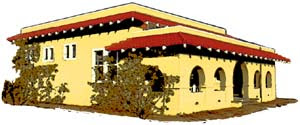Dew Oliver’s Wind Turbine in the eastern San Gorgonio Pass, circa 1927. Wind would enter the large opening to the right and funnel through a series of fans in the smaller cylinder, all turning electrical generators.
By STEVE LECH
Press-Enterprise
When anyone travels between Banning and Palm Springs, he is struck by the seemingly thousands of wind-generating turbines that mar the view of the upper Coachella Valley.
Most of these date to the 1980s and 1990s, but they are not the first such venture to try to tame the wind for energy production.
For that, we must go back to 1926.
In that year, a failed Seal Beach land speculator named Dew Oliver came through the Whitewater area. Convinced he could turn wind into electricity, Oliver traversed the eastern San Gorgonio Pass looking for a location with the strongest and most constant source of wind.
He found such a point on the A. J. Warner ranch just north of the present-day I-10, about half a mile west of the Whitewater exit.
In late 1926, he began construction of Oliver’s Wind Machine.
The machine was basically a 50-foot-long, 12-foot-diameter metal cylinder mounted on a turntable to take advantage of the shifting winds. On the windward side, a large funnel opening to about 50 feet in diameter was secured to the cylinder to funnel the wind into the machine.
In 1955, Harry James interviewed a few local ranchers who had witnessed Oliver’s machine in operation, and they stated that he had generated about 20 horsepower with his “Rube Goldberg contraption.”
However, Oliver’s brush with alternative energy was very short-lived.
First of all, the generator was about 12 miles from Banning and 9 miles from Palm Springs, the nearest population centers at the time. Even if Oliver had generated a substantial amount of power, most of it would have been lost in the transmission lines going to either place.
But the real killer of the project was Oliver himself.
Oliver was a slick salesman, offering himself up as a rich Texas financier. When it looked like his machine would work, he applied for a license to begin selling stock in an energy company.
However, he sold the stock before the license was issued, which got him in trouble.
Hauled into court in Riverside in 1930, Oliver was tried and convicted of fraud and selling securities without a license. He served six months in jail, and then left the area with no trace.
Oliver died in August 1949 in Los Angeles, never realizing his dream.
Tuesday, June 27, 2017
Subscribe to:
Posts (Atom)




